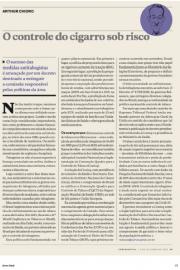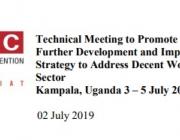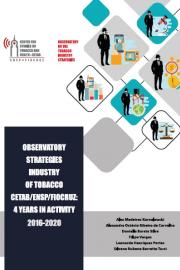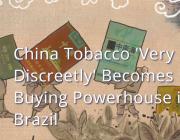100 specialists in nicotine science, policy and practice have come together to call on the 182 parties (countries) to the Framework Convention on Tobacco Control to take a more positive stance on tobacco harm reduction. The letter pushes back against WHO’s misguided and unscientific drive for prohibition or excessive regulation and taxation of vaping products, heated and smokeless tobacco products, and novel oral nicotine products, such as pouches.
ONE hundred specialists call for WHO to change its hostile stance on tobacco harm reduction - new letter to FCTC delegates published. The Counterfactual, Inglaterra, 18 out 2021. Disponível em: https://clivebates.com/one-hundred-specialists-call-for-who-to-change-st.... Acesso em: 1 jul 2024.

Notícia que trata da influência política em prol da promulgação do decreto nº 9.759/2019, do governo Bolsonaro, que versa sobre a extinção de vários colegiados, dentro os quais a Comissão Nacional para implementação da convenção-Quadro para o Controle do Tabaco.
CHIORO, Arthur. O controle do cigarro sob risco: o sucesso das medidas antitabagistas é ameaçado por um decreto destinado a extinguir a comissão responsável pelas políticas da área. Carta Capital, São Paulo, 6 out. 2021.
Background Tobacco companies have maintained a profitable business in Singapore, despite its strong anti-tobacco climate and commitment to protect public health policymaking from tobacco industry interference in line with Framework Convention on Tobacco Control Article 5.3. This study describes how tobacco companies influence policymaking in a highly regulated environment such as Singapore’s, where there is a strong government commitment to Article 5.3.
van der Eijk Y, Tan GPP Tobacco industry’s ‘behind the scenes’ tactics in Singapore Tobacco Control 2023;32:280-286.

"The WHO Framework Convention on Tobacco Control (FCTC) was: 1 negotiated under the WHO Constitutional Mandate; 2 becoming the first convention with a modern structure with objectives in the field of Public Health, but also addressing the social, economic and environmental impact of tobacco. It currently covers more than 90 percent of the global population. It is an evidence-based treaty addressing both the supply and demand of tobacco products and reaffirms the right of all people to the highest standard of health. It guides and informs the global tobacco control agenda and is a legally binding instrument."
DECLARAÇÃO da Secretaria da Convenção-Quadro da OMS para o Controle do Tabaco e o Protocolo para Eliminar o Comércio Ilícito de Produtos de Tabaco. Secretariado da Convenção-Quadro para o Controle do Tabaco, Uganda, 2 jul. 2019.

"A Convenção-Quadro da OMS para o Controle do Tabaco (FCTC) foi: 1 negociada sob a OMS Mandato constitucional; 2 tornando-se a primeira convenção de estrutura moderna com objetivos sobre o campo da Saúde pública, mas também abordando o impacto social, econômico e ambiental do tabaco. Atualmente cobre mais de 90 por cento da população global. É um tratado baseado em evidências abordando tanto o oferta e demanda de produtos de tabaco e reafirma o direito de todas as pessoas ao mais alto padrão de saúde. Ele orienta e informa a agenda global de controle do tabagismo e é um instrumento juridicamente vinculativo."
DECLARAÇÃO da Secretaria da Convenção-Quadro da OMS para o Controle do Tabaco e o Protocolo para Eliminar o Comércio Ilícito de Produtos de Tabaco. Secretariado da Convenção-Quadro para o Controle do Tabaco, Uganda, 2 jul. 2019.

General report that presents an overview of the last 4 years (2016-2020) on the activities of the Observatory team, as well as data on the interference variants of the tobacco industry in Brazil.
TURCI, Silvana Rubano Barretto et al. Observatory on the Tobacco Industry Strategies: 4 years in activity (2016-2020). Cetab/Ensp/Fiocruz, Rio de Janeiro, 17 ago. 2021. 39p.

Relatório geral que apresenta um panorâma dos últimos 4 anos (2016-2020) sobre as atividades da equipe do Observatório, além de dados quanto as variantes de interferência da indústria do tabaco no Brasil.
TURCI, Silvana Rubano Barretto et al. Observatório das estratégias da indústria do tabaco: 4 anos em atividade (2016-2020). Cetab/Ensp/Fiocruz, Rio de Janeiro, 17 ago. 2021. 40p.

China is complying with recommendations under a global treaty to decrease the amount of land under tobacco cultivation - but its massive state-owned conglomerate is shifting production overseas. Brazil has become a major supplier, with farmers working under difficult conditions to grow tobacco for Chinese cigarettes.
HOFMEISTER, Naira; TOLETDO, Luiz Fernando. A China Tobacco 'muito discretamente' se torna uma potência na compra de folhas no Brasil [texto em inglês]. OCCRP, [s.l.], 22 jun. 2021. Disponível em: https://www.occrp.org/en/loosetobacco/china-tobacco-goes-global/china-to.... Acesso em: 23 jun. 2021.
O centro de conhecimento para os artigos 17 e 18 da FCTC - OMS, sediado no Centro de Estudos sobre Tabaco e Saúde - CETAB, produziu um vídeo com a participação de Vera da Costa e Silva, consultora do Cetab, Thomas Novotny da Universidade de San Diego e Eduardo Blanco da OMS, sobre alguns aspectos do tabaco e o meio ambiente em celebração do dia Mundial do Meio Ambiente comemorado no dia 05 de junho.
PROTECTING the environment and the health of persons in relation to the environment - Thomas Novotny. CETAB, Rio de Janeiro, 5 jun 2021. Disponível em: https://youtu.be/APlB3Oxgl9E. Acesso em: 14 jun 2024.